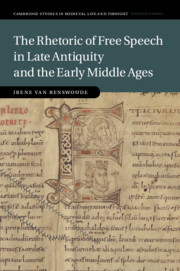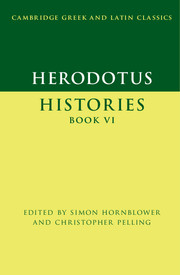Refine search
Actions for selected content:
23990 results in Ancient history
7 - Gregory of Tours
- from Part II
-
- Book:
- The Rhetoric of Free Speech in Late Antiquity and the Early Middle Ages
- Published online:
- 23 September 2019
- Print publication:
- 26 September 2019, pp 161-179
-
- Chapter
- Export citation
Epilogue Part II
- from Part II
-
- Book:
- The Rhetoric of Free Speech in Late Antiquity and the Early Middle Ages
- Published online:
- 23 September 2019
- Print publication:
- 26 September 2019, pp 243-249
-
- Chapter
- Export citation
2 - Hilary of Poitiers
- from Part I
-
- Book:
- The Rhetoric of Free Speech in Late Antiquity and the Early Middle Ages
- Published online:
- 23 September 2019
- Print publication:
- 26 September 2019, pp 41-62
-
- Chapter
- Export citation
Introduction
-
- Book:
- The Rhetoric of Free Speech in Late Antiquity and the Early Middle Ages
- Published online:
- 23 September 2019
- Print publication:
- 26 September 2019, pp 1-18
-
- Chapter
- Export citation
Part I
-
- Book:
- The Rhetoric of Free Speech in Late Antiquity and the Early Middle Ages
- Published online:
- 23 September 2019
- Print publication:
- 26 September 2019, pp 19-130
-
- Chapter
- Export citation
Part II
-
- Book:
- The Rhetoric of Free Speech in Late Antiquity and the Early Middle Ages
- Published online:
- 23 September 2019
- Print publication:
- 26 September 2019, pp 131-249
-
- Chapter
- Export citation
Abbreviations
-
- Book:
- The Rhetoric of Free Speech in Late Antiquity and the Early Middle Ages
- Published online:
- 23 September 2019
- Print publication:
- 26 September 2019, pp ix-x
-
- Chapter
- Export citation
Copyright page
-
- Book:
- The Rhetoric of Free Speech in Late Antiquity and the Early Middle Ages
- Published online:
- 23 September 2019
- Print publication:
- 26 September 2019, pp iv-iv
-
- Chapter
- Export citation
6 - The Frank Holy Man
- from Part II
-
- Book:
- The Rhetoric of Free Speech in Late Antiquity and the Early Middle Ages
- Published online:
- 23 September 2019
- Print publication:
- 26 September 2019, pp 133-160
-
- Chapter
- Export citation

The Rhetoric of Free Speech in Late Antiquity and the Early Middle Ages
-
- Published online:
- 23 September 2019
- Print publication:
- 26 September 2019

Herodotus: Histories Book VI
-
- Published online:
- 14 September 2019
- Print publication:
- 21 December 2017
-
- Textbook
- Export citation

An Introduction to the New Testament and the Origins of Christianity
-
- Published online:
- 10 September 2019
- Print publication:
- 03 January 2019
-
- Textbook
- Export citation
Index
-
- Book:
- Historiography and Space in Late Antiquity
- Published online:
- 12 August 2019
- Print publication:
- 29 August 2019, pp 213-218
-
- Chapter
- Export citation
Acknowledgements
-
- Book:
- Historiography and Space in Late Antiquity
- Published online:
- 12 August 2019
- Print publication:
- 29 August 2019, pp ix-x
-
- Chapter
- Export citation
Bibliography
-
- Book:
- Historiography and Space in Late Antiquity
- Published online:
- 12 August 2019
- Print publication:
- 29 August 2019, pp 181-212
-
- Chapter
- Export citation
Chapter 1 - Constantinople’s Belated Hegemony
-
-
- Book:
- Historiography and Space in Late Antiquity
- Published online:
- 12 August 2019
- Print publication:
- 29 August 2019, pp 14-35
-
- Chapter
- Export citation
Chapter 4 - Narrative and Space in Christian Chronography
-
-
- Book:
- Historiography and Space in Late Antiquity
- Published online:
- 12 August 2019
- Print publication:
- 29 August 2019, pp 86-112
-
- Chapter
- Export citation
Chapter 5 - The Roman Empire in John of Ephesus’s Church History
-
-
- Book:
- Historiography and Space in Late Antiquity
- Published online:
- 12 August 2019
- Print publication:
- 29 August 2019, pp 113-135
-
- Chapter
- Export citation
Chapter 6 - Changing Geographies
-
-
- Book:
- Historiography and Space in Late Antiquity
- Published online:
- 12 August 2019
- Print publication:
- 29 August 2019, pp 136-163
-
- Chapter
- Export citation
Contributors
-
- Book:
- Historiography and Space in Late Antiquity
- Published online:
- 12 August 2019
- Print publication:
- 29 August 2019, pp vii-viii
-
- Chapter
- Export citation
